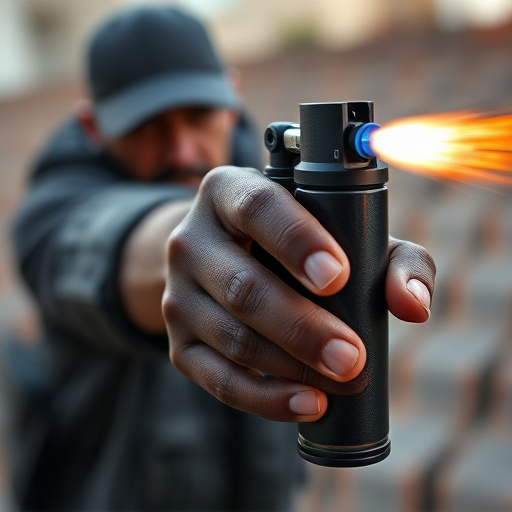Law enforcement agencies worldwide employ riot control agents like pepper spray for crowd management during civil unrest, adhering to strict regulations that govern their use and carrying. Effective deployment requires strategic techniques, including concealed carrying methods, quick access, and tailored de-escalation strategies. Regular training exercises are crucial to prepare officers for unpredictable events, ensuring the safe and responsible use of pepper spray while balancing public safety and individual rights.
Riot control agents, such as pepper spray, have become integral tools in law enforcement, offering a range of options for managing chaotic situations. This article explores the complex world of these agents, delving into their types and varying effects on crowd control. We examine the legal landscape surrounding concealed pepper spray carrying by police, highlighting key regulations and training strategies for optimal deployment. Additionally, ethical considerations and public safety are at the forefront, addressing the importance of responsible use in diverse law enforcement operations. Effective techniques for concealed pepper spray carrying are explored, ensuring officer safety while mitigating civil liberties concerns.
- Understanding Riot Control Agents: Types and Their Effects
- Legal Framework: Regulations on Concealed Pepper Spray Carrying by Law Enforcement
- Effective Training and Deployment Strategies for Riot Control Agents
- Ethical Considerations and Public Safety in the Use of Pepper Spray During Law Enforcement Operations
Understanding Riot Control Agents: Types and Their Effects
Riot control agents, also known as less-lethal weapons, are chemical substances designed to disrupt and disperse crowds or individuals involved in civil unrest or violent demonstrations. These agents play a significant role in law enforcement strategies for crowd management, offering an alternative to lethal force. Understanding the types and effects of these agents is crucial for both officers and the public, especially with the rise in popularity of concealed pepper spray carrying techniques among civilians for self-defense.
Commonly used riot control agents include pepper spray, tear gas, and rubirol (or rubber bullets). Pepper spray, a popular choice due to its effectiveness and relatively low risk, causes temporary blindness, coughing, and difficulty breathing upon impact. Tear gas, on the other hand, creates a choking sensation and tears the eyes, leading to temporary blindness. Rubirol projectiles, though non-lethal, can cause pain and skin irritation upon impact. Mastering concealed carrying techniques for these agents requires training and practice, emphasizing safety and responsible use in diverse scenarios.
Legal Framework: Regulations on Concealed Pepper Spray Carrying by Law Enforcement
In many jurisdictions, law enforcement agencies are subject to strict regulations regarding the use and carrying of riot control agents, with a particular focus on concealed pepper spray techniques. These rules are designed to ensure the safe and responsible handling of such powerful substances, while also allowing officers the necessary tools for effective crowd control and self-defense. The legal framework typically dictates specific requirements for training, licensing, and equipment standards, ensuring that officers are competent in using pepper spray as a last resort when other de-escalation methods fail.
The regulations often vary by region, but common themes include mandating the use of specialized holsters or containers to securely store and transport the spray, along with detailed instructions on when and how to deploy it. Officers must also be familiar with their rights and responsibilities under the law, including the need to minimize harm and ensure proportionality in their use of force. These measures reflect a balanced approach, acknowledging the strategic value of concealed pepper spray carrying while prioritizing public safety and accountability.
Effective Training and Deployment Strategies for Riot Control Agents
Riot control agents, such as pepper spray, require strategic deployment and handling to ensure effectiveness and officer safety. Effective training should cover not only the technical aspects of using these agents but also tactical deployment strategies. Officers must learn concealed carrying techniques for pepper spray, mastering how to quickly access and deploy it during high-pressure situations. This includes practicing various holstering methods suitable for different uniform styles and scenarios.
Deployment strategies should be tailored to specific riot control needs. For instance, in close-quarter combat, officers might prefer a more direct approach with instant release mechanisms. In contrast, longer-range encounters may benefit from specialized spray canisters that allow for greater accuracy and distance. Regular training exercises simulating real-world scenarios will help law enforcement prepare for unpredictable events, ensuring they use riot control agents judiciously and safely.
Ethical Considerations and Public Safety in the Use of Pepper Spray During Law Enforcement Operations
The use of riot control agents, like pepper spray, by law enforcement raises complex ethical questions and necessitates a delicate balance between public safety and individual rights. While pepper spray is often employed to subdue and control agitated individuals during high-tension situations, its non-lethal nature also makes it a controversial tool. Ethical considerations come into play when evaluating the appropriateness of its use, especially given that it can cause significant discomfort and temporary disability.
Law enforcement agencies must train their officers in proper carrying techniques for concealed pepper spray, ensuring they understand the implications of its misuse. These techniques include learning to assess the level of threat, understanding de-escalation strategies, and knowing when and how to deploy the spray while minimizing harm to bystanders and the targeted individual’s long-term health effects. The responsible use of pepper spray can be a game-changer in managing crowd control during protests or civil disturbances, but it requires ongoing dialogue and oversight to maintain public trust and safety.
Riot control agents, particularly concealed pepper spray, have become integral tools for law enforcement in managing public disorder. The legal framework surrounding their carrying underscores the need for balanced regulation, ensuring officers are trained effectively to deploy these agents strategically while prioritizing public safety and ethical considerations. By adopting best practices, including comprehensive training programs, safe storage, and clear protocols, law enforcement agencies can harness the power of concealed pepper spray carrying techniques, enhancing their ability to maintain peace and order in diverse situations.
